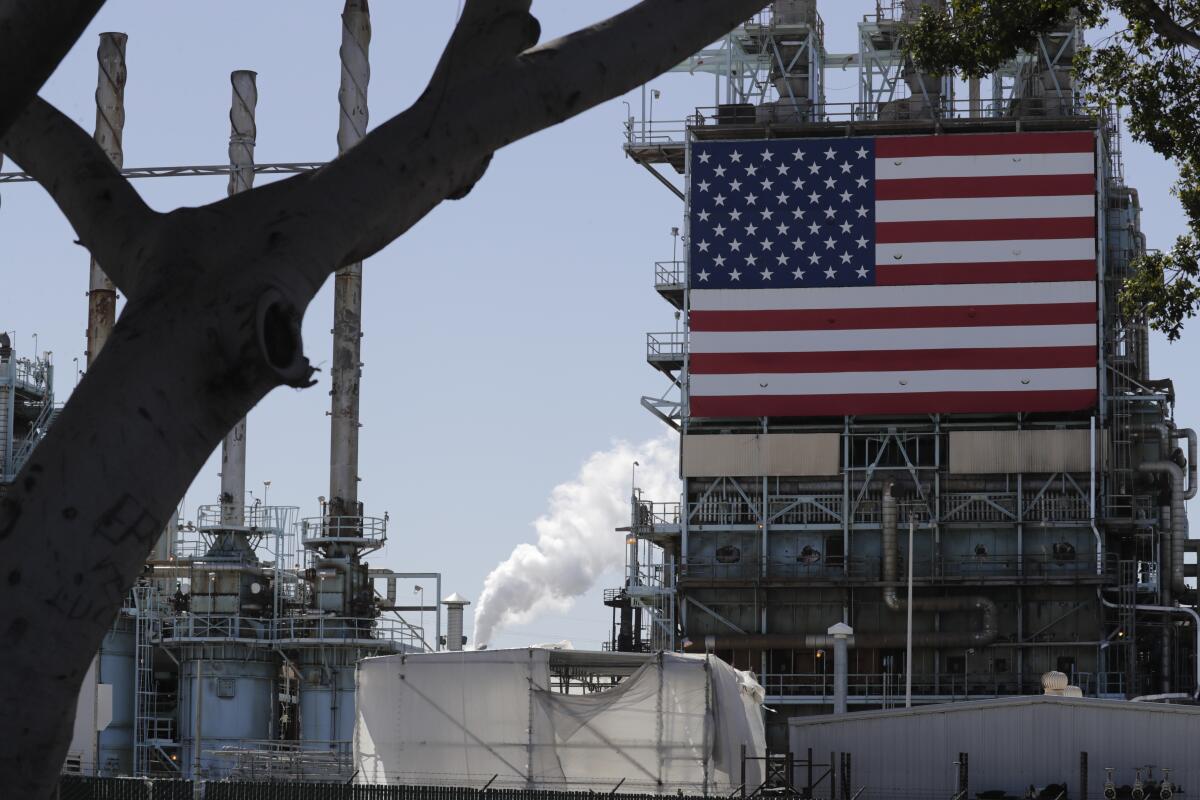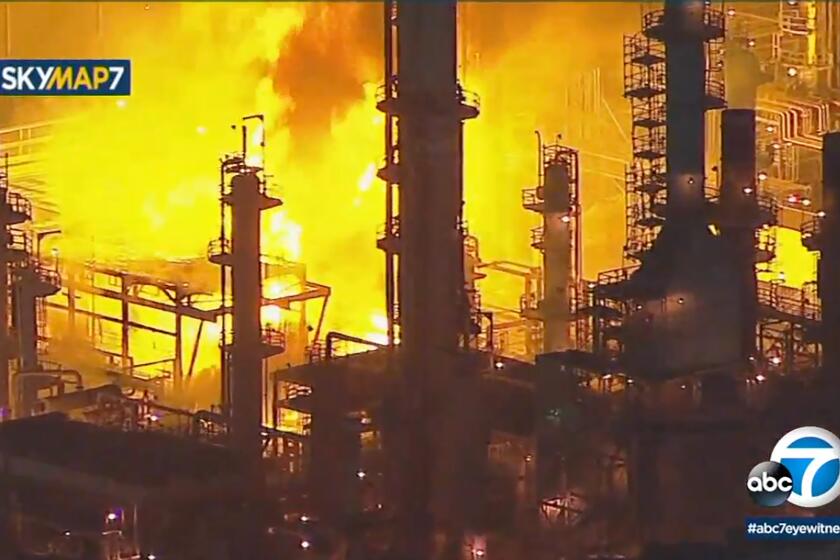Refinery neighbors are used to fires. But the Carson explosion was ‘scary’

- Share via
Juliet Alvarez was preparing to sleep when she heard the explosion.
Curious, worried, she wandered to the backyard of her Carson home. There, she saw what was unfolding at the nearby Marathon Petroleum refinery: smoke first, then fire.
“It got really warm,” the 28-year-old recalled Wednesday. “That was the scary part. You could just feel the heat from the fire.”
Alvarez was one of numerous people — some as far away as Glendale, Studio City and Atwater Village — who were jolted late Tuesday when part of the refinery exploded, sparking a spectacular blaze that shot flames 100 feet into the air and took firefighters half the night to get under control, officials said.
The fire, at least the third such incident at a California refinery since 2012, was a reminder that the region’s many refineries are complex industrial facilities, with the potential for accidents and ignitions at any moment. Officials for the California Division of Occupational Safety and Health (Cal-OSHA) said they have launched an investigation.
Tuesday night’s fire was knocked down about 3:50 a.m. Wednesday, roughly five hours after the explosion in a cooling tower at the facility, according to the Los Angeles County Fire Department. Hazardous materials teams continued to monitor air quality in the area after the flames were doused, but detected no public health threats, the department said.
Inspectors from the South Coast Air Quality Management District collected samples during the fire that will be analyzed for toxic gases. Those results are expected by Thursday morning, but monitors installed around the facility’s perimeter show no elevated levels of such substances, according to a statement from the agency.
The district is investigating 13 complaints received from the neighboring community and “will evaluate whether any regulatory violations occurred.”
“If you see or smell smoke, limit your exposure by remaining indoors with windows and doors closed,” officials said.
Despite assurances from authorities and air quality experts, some were worried about the health effects from the fire.
Coalition for Clean Air President Joseph Lyou, whose group has an air quality monitor southeast of the Carson refinery, said its readings showed no obvious signs of fine-particle pollution from the fire.
“The community members living near the refinery need to be prepared to shelter in place and take other protective measures. Explosions and fires can have immediate health impacts,” Lyou said in an email.
Fe and William Koons were watching television inside their Carson home Tuesday night when they felt a series of booms powerful enough to shake the windows.
“It was scary,” Fe Koons said. “I thought it was going to be an earthquake. It was that loud.”
The Koons have dealt with refinery hazards over the three-plus decades they’ve lived near the Carson facility. They’ve experienced other fires, and ash raining down on their cars, but they can’t remember anything that shook the house like this.
Koons said the neighborhood may have been lucky that the fire broke out at night, when most people are inside and there was little wind to spread the smoke.
“But it’s not fair that the lives of the people around the refinery are at risk,” she said. “There’s a school, and a park where children play. What if that happened in the morning when there are children in the park and at the school?”
The Carson refinery is the largest on the West Coast, with a crude oil capacity of 363,000 barrels per day, according to Marathon Petroleum Corp. All of the facility’s personnel have been accounted for, and no injuries were reported, according to company spokeswoman Brianna Patterson.
“Our priority is to ensure the safety of people and the surrounding community and to limit environmental impact,” she said in an email.
Los Angeles County’s South Bay and Harbor areas are dotted with refineries that have a history of accidents and health-damaging air pollution. Some explosions have been so powerful they registered on seismic scales, or spewed so much dust, smoke and toxic air pollution that regulators have had to warn residents to stay inside to protect their lungs.
More than 180,000 people live within 3 miles of the Marathon Petroleum refinery in Carson, where the fire occurred this week, according to the U.S. Environmental Protection Agency. It’s one of Southern California’s seven major oil refineries in Carson, El Segundo, Wilmington and Torrance.
Five years ago an explosion rocked the Torrance Refinery — so powerful it registered the equivalent of a magnitude 1.7 earthquake — spewing smoke and dust over surrounding communities. The February 2015 blast sent a 40-ton piece of equipment just short of crashing into a massive tank containing hydrofluoric acid, a dangerous chemical that can form a deadly, ground-hugging cloud.
The U.S. Chemical Safety Board called it a “serious near miss” that could have resulted in a “potentially catastrophic release” killing or injuring many people nearby.
Tuesday’s fire prompted a brief closure of all lanes of the 405 Freeway at Wilmington Avenue, according to the California Highway Patrol. All lanes reopened by about 11:45 p.m. after being closed for about 30 minutes.
The fire could inconvenience motorists in other ways.
Since part of the refinery was shut down Wednesday, California gasoline prices may rise modestly. Within a week or two, prices at the pump could be up 10 to 15 cents per gallon, said Patrick DeHaan, head of petroleum analysis at Gas Buddy, a company that tracks real-time gas prices.
California already has begun to see an effect, with prices Wednesday in Los Angeles up about 7 cents and those in San Francisco up 12 cents.
“It should not be a dramatic overnight spike,” DeHaan said.
California motorists may see gas prices rise modestly as a result of the fire at a refinery in Carson on Tuesday night.
The jump in gas prices may be offset by fears of coronavirus driving oil prices down significantly. But California drivers likely will still feel an impact, as the Marathon refinery is the only one in the state able to process 350,000 barrels a day.
“The silver lining is it’s happening at a time of year where demand is reduced and oil prices remain relatively low. The market may be reacting less than if it had happened out of the blue in the middle of summer,” when gas is in peak demand, DeHaan said.
Statewide, a gallon of gas cost an average of $3.48 as of Wednesday — well above the national average of $2.47, according to the American Automobile Assn.
Times staff writer Susanne Rust contributed to this report.
More to Read
Sign up for Essential California
The most important California stories and recommendations in your inbox every morning.
You may occasionally receive promotional content from the Los Angeles Times.















